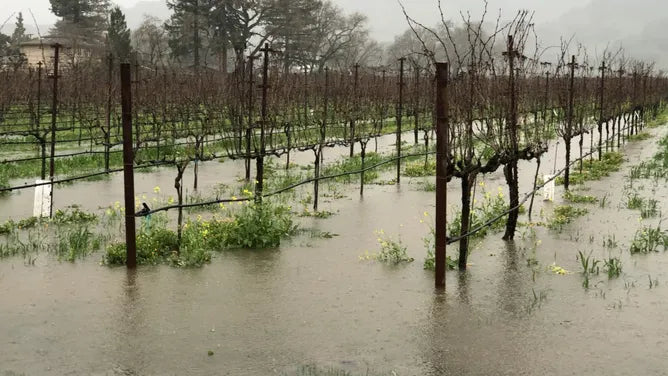I was looking forward to a beautiful drive up to Napa Valley last Saturday. What I got was still beautiful, but very rainy. And it made me wonder, like it does for most wine lovers, what this late-season moisture will do to the 2024 Napa vintage?
Napa Valley, known for its prestigious wines and vineyards, boasts an exceptional climate for growing grapes. The region's Mediterranean climate, with its warm days and cool nights, is a magical, one-of-a-kind terroir. However, the occurrence of late-season rains, specifically in April and May, can pose serious challenges to the grape crop and affect the resulting wines.
The Significance of Late-Season Rains In Napa Valley
Typically, Napa Valley experiences a dry season starting in late spring and continuing through summer and fall. This dry period is essential for the health and quality of the grape crop. Late-season rains, however, can disrupt this pattern and bring about various changes to grapevines and the subsequent wine produced.
1. Grapevine Growth and Development
Late-season rains can impact the growth and development of grapevines in a few ways:
-
Delayed Ripening: Rain in April and May can extend the growing season by delaying the ripening process. This shift can lead to a later harvest, which may affect the overall quality of the grapes.
-
Vine Health: Excess moisture can increase the risk of fungal diseases such as powdery mildew and botrytis (grey mold). These diseases can damage the vines and grapes, potentially affecting both yield and quality.
-
Vineyard Management: Late-season rains may require vineyard managers to adjust their irrigation practices and pest management strategies to account for the unexpected moisture.
2. Impact on Yield
Late-season rains can have a significant impact on grape yield:
- Cluster Compaction: Rainfall during the growing season can lead to tighter grape clusters, which may increase the risk of rot.
- Shatter: If the rainfall is hard enough, it can "shatter" new buds, resulting in decreased yields.
- Reduced Quantity: If the vines are stressed due to excess moisture, the grape yield may be reduced. This could potentially affect the volume of wine produced.
Effect on Wine Quality
The quality of wine produced from late-season rain-affected grapes can vary depending on several factors, including the variety of grape and the winemaking process.
-
Flavor Profile: Late-season rains can dilute the grape's sugar content and lower its concentration of flavors. This can result in wines with less intensity and complexity.
-
Acidity: In some cases, late-season rains may increase the acidity levels in the grapes, which could influence the wine's overall taste and structure.
-
Vintage Variation: Variations in rainfall and climate can lead to vintage-to-vintage differences in wine quality. Some years may produce wines with unique characteristics due to the influence of late rains.
Napa Valley Vintages Affected By Late Season Rainfall
When it comes to late-season rainfall having an affect on the quality of Napa Valley wines, there are three vintages in the last 20 years that come to mind immediately:
-
2019 Vintage: The 2019 growing season experienced heavy rainfall in late spring. While this initially caused concerns about the impact on the grape crop, winemakers were able to navigate the challenges, and the resulting wines have been described as elegant and balanced. For Magna Carta Cellars, our 2019 Proprietary Red came out as one of the softest, most-balanced wines we've produced.
-
2011 Vintage: This is the doozy. The prolonged wet period posed challenges such as increased disease pressure and delayed harvests. Despite this, some winemakers were able to produce wines with bright acidity and freshness.
-
2005 Vintage: In 2005, late rains were prevalent in Napa Valley. The growing season was challenging, and some winemakers had to be meticulous in their vineyard management to combat the effects of moisture. The resulting wines were generally lower in alcohol, but still offered good balance and complexity.
Conclusion
If you've ever been to Napa, you know that every day is a beautiful day in the Valley, even when it rains. But late-season rains in Napa Valley can present challenges for grape growers and winemakers alike. The timing and intensity of the rainfall can affect grapevine health, yield, and the flavor profile of the resulting wines. However, skilled vineyard management and winemaking practices can help mitigate these challenges and produce high-quality wines even in years with unexpected weather events.
Despite the potential difficulties, the dynamic nature of wine production in Napa Valley often results in wines that reflect the unique character of each vintage. Whether the late-season rains bring surprises or obstacles, Napa Valley's winemakers continually adapt and strive to create exceptional wines that showcase the region's terroir.

